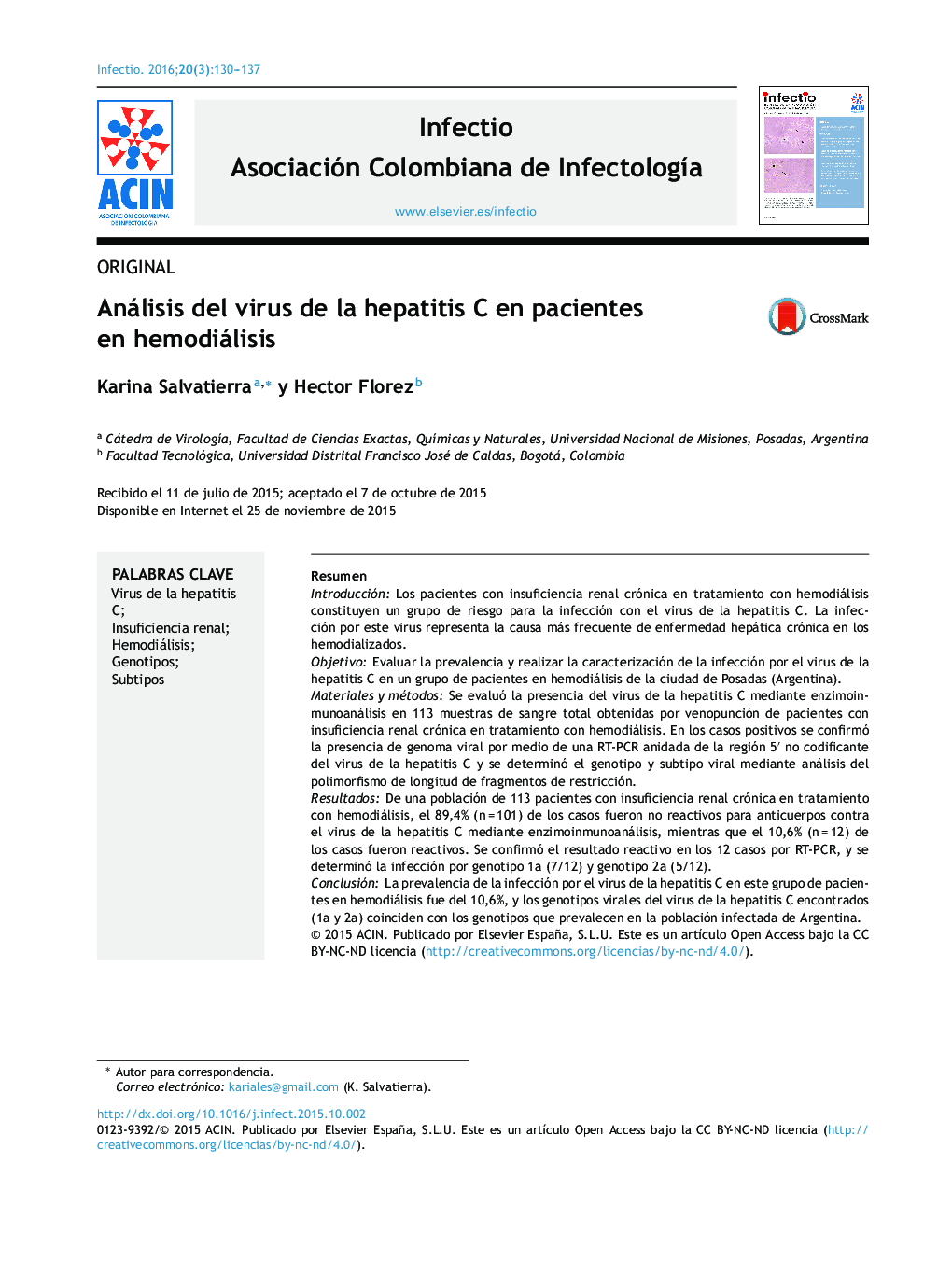| Article ID | Journal | Published Year | Pages | File Type |
|---|---|---|---|---|
| 3403619 | Infectio | 2016 | 8 Pages |
ResumenIntroducciónLos pacientes con insuficiencia renal crónica en tratamiento con hemodiálisis constituyen un grupo de riesgo para la infección con el virus de la hepatitis C. La infección por este virus representa la causa más frecuente de enfermedad hepática crónica en los hemodializados.ObjetivoEvaluar la prevalencia y realizar la caracterización de la infección por el virus de la hepatitis C en un grupo de pacientes en hemodiálisis de la ciudad de Posadas (Argentina).Materiales y métodosSe evaluó la presencia del virus de la hepatitis C mediante enzimoinmunoanálisis en 113 muestras de sangre total obtenidas por venopunción de pacientes con insuficiencia renal crónica en tratamiento con hemodiálisis. En los casos positivos se confirmó la presencia de genoma viral por medio de una RT-PCR anidada de la región 5′ no codificante del virus de la hepatitis C y se determinó el genotipo y subtipo viral mediante análisis del polimorfismo de longitud de fragmentos de restricción.ResultadosDe una población de 113 pacientes con insuficiencia renal crónica en tratamiento con hemodiálisis, el 89,4% (n = 101) de los casos fueron no reactivos para anticuerpos contra el virus de la hepatitis C mediante enzimoinmunoanálisis, mientras que el 10,6% (n = 12) de los casos fueron reactivos. Se confirmó el resultado reactivo en los 12 casos por RT-PCR, y se determinó la infección por genotipo 1a (7/12) y genotipo 2a (5/12).ConclusiónLa prevalencia de la infección por el virus de la hepatitis C en este grupo de pacientes en hemodiálisis fue del 10,6%, y los genotipos virales del virus de la hepatitis C encontrados (1a y 2a) coinciden con los genotipos que prevalecen en la población infectada de Argentina.
IntroductionPatients with chronic renal failure on hemodialysis comprise a risk group for infection with hepatitis C. This viral infection is the most common cause of chronic liver disease in hemodialysis.ObjectiveTo evaluate the prevalence and to characterise hepatitis C virus infection in a group of patients from the city Posadas (Argentina) who are on hemodialysis.Materials and methodsThe presence of the virus of hepatitis C was evaluated by enzyme immunoassay of 113 samples of whole blood obtained from patients with chronic renal failure undergoing hemodialysis. In positive cases, the presence of the viral genome was confirmed by RT-nested PCR of the 5’-noncoding region of the hepatitis C virus, and the viral genotype and subtype were determined by restricted fragment length polymorphism analysis.ResultsOf a population of 113 patients with chronic renal failure on hemodialysis, the detection of hepatitis C virus infection was performed by enzyme immunoassay, of which 89.4% (n = 101) of the cases were non-reactive, and 10.6% (n = 12) of cases were reactive. We confirmed the reactive results in 12 cases by RT-PCR, and we determined that these cases were genotype 1a (7/12) and genotype 2a (5/12).ConclusionThe prevalence of infection with hepatitis C virus in this group of patients on hemodialysis was 10.6%, and the hepatitis C virus genotypes found (1a and 2a) were the same as the prevalent genotypes in the infected population of Argentina.
